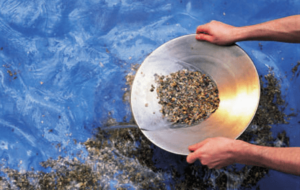You may not know that every river in the world contains traces of gold. However, some rivers contain so little gold that they are impossible to pan, whereas others are illegal to do so in. Here we detail the panning process and how an amateur can find gold in nature, rather than in a vault.
How to Pan
 Gold panning is a form of recreational gold mining which, although simple and free, is unlikely to yield valuable amounts of the precious metal. Specifically, panning extracts gold from a placer deposit using a pan, giving the process its name. Once a suitable placer deposit is located, some of the mineral is scooped into a pan, where it is then gently agitated in the river, until the gold sinks to the bottom of the pan.
Gold panning is a form of recreational gold mining which, although simple and free, is unlikely to yield valuable amounts of the precious metal. Specifically, panning extracts gold from a placer deposit using a pan, giving the process its name. Once a suitable placer deposit is located, some of the mineral is scooped into a pan, where it is then gently agitated in the river, until the gold sinks to the bottom of the pan.
Where You Will Find Gold
Finding gold requires a degree of geological knowledge, given that the proximity of particular rivers to specific rock formations will dictate whether it possesses a degree of the precious metal. Simply, rivers that pass through regions which contain granite, granodiorite, basalt, and other metamorphic rocks are the best sources of the element. Conversely, geological regions that are rich in limestone, marbles and sandstones will usually yield insufficient traces of gold to pan. Although appropriate rivers can be found throughout the world (notable UK panning traps can be found in Eastern Scotland and the Lake district), you should also be mindful of panning in a river where the water runs rapidly, then calms after passing over a small rapid or waterfall. Specifically, small pools below rapids that contain heavy concentration of mineral are the best place to start panning.
Where Is it Legal and Safe to Pan for Gold?
It should be noted that panning is not legal everywhere. Specifically, it is illegal to pan for gold in national parks, archeologic preserves, or in someone else’s mineral claim. Therefore, a good way to determine whether it is acceptable to start panning is to contact your local rock hound club, contact details of which can be found in your nearest rock shop or university geology department.
